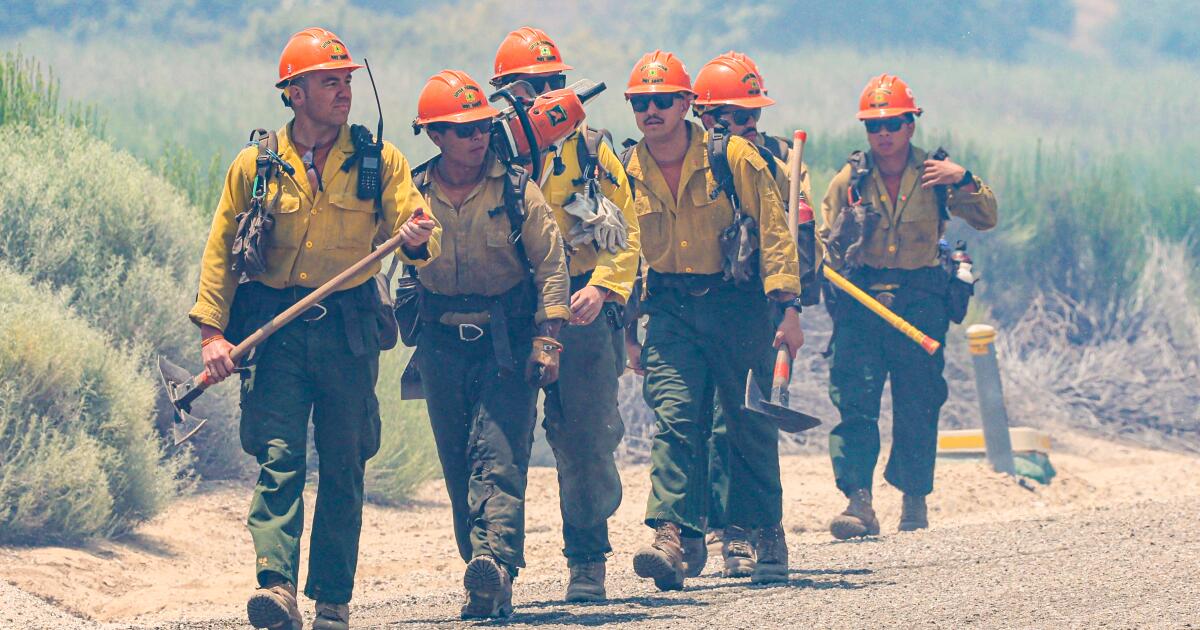Good morning, Paul Thornton here. Today is Saturday, June 22, 2024. Here’s what I covered in Opinion:
Los Angeles needs more housing, and its homelessness statistics make that clear. The problem is that more than three-quarters of the city’s 469 square miles of land are zoned for single-family homes, leaving the task of alleviating the housing shortage to a small part of the city. As The Times editorial board pointed out this week, Los Angeles cannot be an affordable city as long as its leaders stick to single-family zoning.
Two further facts further support the editorial’s call for greater density in Los Angeles: the wildfires currently raging through much of the state and the frightening heat dome that has been hovering over Southern California this weekend, driving dangerously high temperatures, especially inland. These two calamities seem unrelated to the housing crisis, but they underscore the need to build more housing in the city’s single-family neighborhoods.
First, the fire. Heading north from Los Angeles on the 5 Freeway, the Post Fire has burned nearly 16,000 acres since it started on Sunday near Tejon Pass near Gorman. Those who pay attention to housing policy in Southern California may know that the area is adjacent to the Centennial housing development. Centennial is a suburban housing project that would build 19,333 homes on land owned by Tejon Ranch. The project, which proponents tout as relieving the state’s housing shortage, is located more than 70 miles from downtown Los Angeles on undeveloped land designated by the state as a high fire hazard area, but the Los Angeles County Board of Supervisors approved the project in late 2018. Last year, an LA County judge denied the county’s approval of Centennial, citing wildfire risk (and a host of other environmental concerns), dealing a potentially fatal blow to the project.
New suburban housing developments are built on these lands (“greenfield” developments) because it’s cheaper and less of a regulatory pain than getting approval to build housing in cities with extensive single-family zoning. But while building housing in places like Tejon Ranch, far from Los Angeles’ housing NIMBYs, may make economic sense, it makes no sense environmentally in an era of climate change and intense wildfires. The Post Fire, burning close to where 20,000 future homes will be built, makes frighteningly clear why it’s so important to increase housing density within Los Angeles.
Second, extreme heat. Yes, it’s hot in Los Angeles right now, but much of the region sits near a natural air conditioner: the Pacific Ocean. As a general rule, the further away from the coast you are, the more extreme the temperatures become. Coastal areas are crowded in part because the weather is nice, but as climate change worsens and summer heatwaves become more intense, they become more of a safety issue than a personal weather preference. As our editorial board pointed out in another article this week, extreme heat is already California’s deadliest weather phenomenon, and if current rates of greenhouse gas emissions continue, it could kill more than 11,000 Californians annually by mid-century.
So affordable housing is also a climate justice issue: creating more places for people to live on the coast of Los Angeles, where the dangers of heat are less severe than in the “affordable” inland areas, could save lives as temperatures rise. People would be able to live in places where the weather won’t kill them.
As fires flare up again, is California becoming uninsurable? Insurance industry advocate Rex Fraser says not, but California’s market problems are fixable. Allowing insurers to price homeowners insurance based on projected payments rather than historical averages would help, he says. Consumer watchdog Jamie Cote says the changes supported by Fraser and the state insurance commissioner would certainly raise premiums but wouldn’t necessarily enable more Californians to get insurance.
The great powers are eager for a new nuclear arms race. Who can stop it? The Biden administration has announced a “competitive” nuclear strategy that could lead to further deployment of nuclear weapons. This could be a major change in U.S. practice, but the public has not been involved in nuclear policy for decades, leaving it to a small group of strategists. “Ordinary Americans can and should campaign against this dangerous nuclear expansion,” wrote Steve Andreasen of the National Security Council.
Are you enjoying this newsletter? Consider subscribing to the Los Angeles Times
Your support helps us deliver the news that matters most: Become a subscriber.
Why next week’s Biden-Trump showdown is novel, and what it means for future presidential debates. Voters have come to expect certain conditions from presidential debates: They follow a strict format, are held late in the campaign (or at least after the candidates have been nominated), and have a neutral moderator. The idea is that this is in the public interest. Political science professor Seth Masket says that all that could change next week.
By keeping guns away from domestic violence suspects, the Supreme Court has set an example for other courts. The Court’s common-sense decision will save lives and increase the likelihood that other gun restrictions will be upheld, wrote University of California, Berkeley Law Dean Erwin Chemerinsky. “After hundreds of challenges to these laws over the past two years, lower courts have been divided on whether the restrictions violate the Second Amendment. There is now a strong case to uphold the restrictions.”
More of this week’s thoughts
From the columnist
From the Opinion Desk
From the Editorial Board
Letter to the editor

